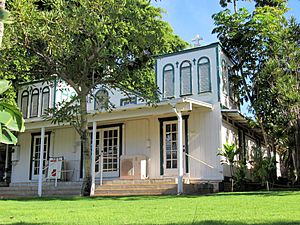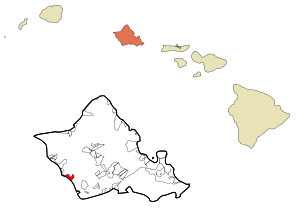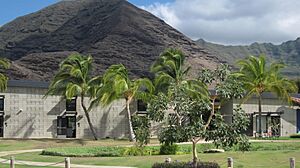Nānākuli, Hawaii facts for kids
Quick facts for kids
Nānākuli
|
|
|---|---|

St. Rita Catholic Church in Nānākuli
|
|

Location in Honolulu County and the state of Hawaii
|
|
| Country | United States |
| State | Hawaii |
| Area | |
| • Total | 6.57 sq mi (17.01 km2) |
| • Land | 2.99 sq mi (7.74 km2) |
| • Water | 3.58 sq mi (9.26 km2) |
| Elevation | 10 ft (3 m) |
| Population
(2020)
|
|
| • Total | 12,195 |
| • Density | 4,079.96/sq mi (1,575.27/km2) |
| Time zone | UTC-10 (Hawaii-Aleutian) |
| ZIP code |
96792
|
| Area code(s) | 808 |
| FIPS code | 15-53900 |
| GNIS feature ID | 0362575 |
Nānākuli (pronounced naːnaːˈkuli) is a special area on the west coast of Oʻahu island in Hawaii. It's called a census-designated place (CDP). This means it's a place where people live that is defined for counting the population, but it's not an official city or town. In the Hawaiian language, nānā kuli means "look at knee." In 2020, about 12,000 people lived there.
Contents
Where is Nānākuli?
Nānākuli is about 48 kilometers (30 miles) away from Honolulu, the capital city of Hawaii. It is located near the southern part of the Waiʻanae mountain range. You can reach Nānākuli by using Farrington Highway. Most people in Nānākuli live in the valley area. A popular spot for fun and relaxation is Nānākuli Beach Park.
Who Lives in Nānākuli?
| Historical population | |||
|---|---|---|---|
| Census | Pop. | %± | |
| 2020 | 12,195 | — | |
| U.S. Decennial Census | |||
In 2020, there were 11,461 people living in Nānākuli. This was a small decrease from the 12,666 people counted in 2010.
The average age of people living there was about 31.5 years old. The typical household earned around $75,031 per year. The average value of a home was about $370,600. Most households owned about two cars. Around 15.3% of the people lived below the poverty line.
The main ethnic groups in Nānākuli are:
- Native Hawaiian and Other Pacific Islander (about 46%)
- Multiracial (about 28%)
- Multiracial (Hispanic) (about 7.9%)
- Asian (about 6.8%)
Native Hawaiian Community
Nānākuli is special because it's home to one of the oldest Hawaiian Home Land Divisions. These lands were set aside for Native Hawaiians through a law called the Native Hawaiian Homes Commission Act of 1921. Prince Jonah Kūhiō Kalanianaʻole helped make this law happen.
The presence of the Department of Hawaiian Home Lands (DHHL) has greatly shaped the Nānākuli community. For over 50 years, three public schools in Nānākuli have been built on these Hawaiian Home Lands. These schools are Nānākuli High and Intermediate, Nānā I Ka Pono, and Nānākuli Elementary.
In recent years, these schools have started offering learning programs focused on Native Hawaiian culture. For example, at Nānākuli Elementary, kids can join a Hawaiian language immersion program called Kula Kai O Puni. Besides the Department of Education schools, there's also a special school called "Ka Waihona O Ka Naʻauao Hawaiian Public Charter School."
Recently, the local community board decided to rename Nānākuli Beach Park after Kalaniʻanaole to honor the valley's long history and the DHHL.
Other Native Hawaiian groups also help the community. These include the Liliʻuokalani Trust (which used to be called the Queen Liʻliʻuokalani Children's Center), the Office Of Hawaiian Affairs, and Kamehameha Schools. In April 2021, Kamehameha Schools opened the Kalanihookaha Community Learning Center in Nānākuli.
About 3,970 residents in Nānākuli have some Hawaiian ancestry.
Education
The Hawaii Department of Education manages the public schools in Nānākuli. The area has two elementary schools, Nanaikapono and Nanakuli, and one middle and high school, the Nanakuli High & Intermediate School.
Notable Residents
Many interesting people have lived in Nānākuli, including:
- Konishiki Yasokichi
- Jason Momoa
- Radasha Ho'ohuli, who was Miss Hawaii USA in 2006
- Raymond Kane
- Mark Tuinei (1960–1999), a former NFL player
- MDMP, a rock band started in 2017 by local musician Jeremey Meyer.
See also
 In Spanish: Nanakuli para niños
In Spanish: Nanakuli para niños


